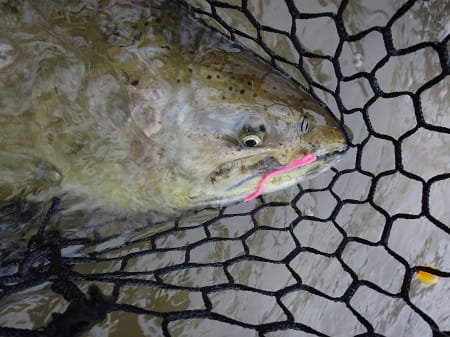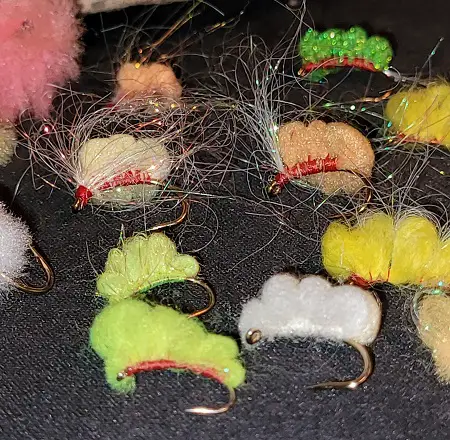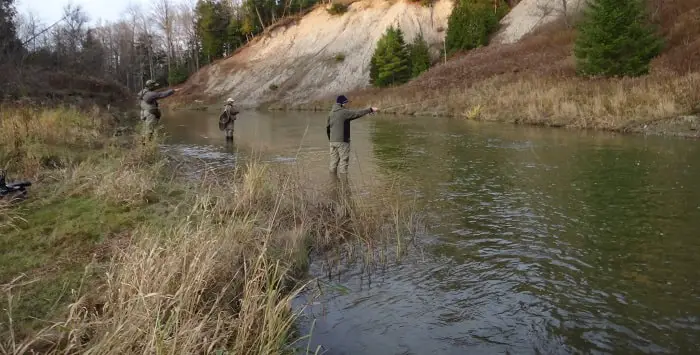Nymphing For Salmon: How The Guides Do it

I first started fly fishing for salmon when I was thirteen, and back then, I had no idea what I was doing, but I knew enough to do what other good anglers were doing to catch salmon, which was nymphing.
Today, I am one of the top guides in my area, and I have over 37 years of experience fishing for salmon with a fly rod, and now I teach nymphing for salmon.
I can honestly say nymphing is the most effective way to catch salmon when fishing small to mid-sized rivers or when salmon are holding in pools, pockets, or riffles.
Nymph fishing for salmon is a fly fishing technique that is used by anglers to drift small imitation fly patterns known as nymphs, or it can also be fish eggs, worms, and other food sources known to salmon, in a way that looks natural to the salmon.
There are two nymph fishing methods for salmon. The most common method is indicator fishing, where you suspend your flies under an indicator, and this works on most water. Euro nymphing is a newer method and is extremely effective in shallow runs and pocket water.
6. Keys To Nymphing For Salmon
- Gear: Some salmon are very big so ensure you have strong rods, reels, and line that can handle these big fish. Use long rods: They are better for mending, line control, presentation, and protect light tippets.
- Leader Setup: Use a proven leader setup that is light enough to get more bites but strong enough not to break. A twelve to 16-pound tippet is usually good.
- Method: Use indicator nymphing in larger deeper spots or when it’s windy. Use Tight-line nymphing in shallow water, smaller spots, and pocket water.
- Reading The Water: Learn travel routes and holding spots to target and catch more salmon.
- Presentation: Learn to get a natural drag-free drift to entice more salmon to bite.
- Flies: have an assortment of flies ranging from brightly colored egg patterns to black and brown nymphs.

Once salmon enter the river, they will almost exclusively eat food below the surface, so if an angler is good at presenting their fly below the surface, they will have a much better chance of catching salmon in any river.
This makes nymphing the most effective fly fishing method.
Do Salmon Eat Nymphs?

Although anglers have known this for many years, it has been proven in recent studies that salmon will eat nymphs once they enter the rivers to spawn.
It was determined that spawning salmon, at all stages of the spawn, will occasionally eat eggs, nymphs, worms, and even baitfish if it drifts past them. (1)
The salmon are not actively hunting for food, but they will eat if something drifts close enough to them, and the stomach contents in the studies prove this.
Whether they feed on nymphs out of hunger, aggression, instinct, or habit, they will often take a well-presented nymph.

When and Where to Fish Nymphs

You can nymph fish for salmon on any river, big or small, fast or slow, deep or shallow, but nymphing is best in pocket water, and shallower riffles and runs, and in smaller pools under 6 feet deep.
Best Nymphs For Salmon Fishing

I have found through experience that many of the nymph patterns that I use will do better with extra flash.
In my experience, I have found that a little flash goes a long way for salmon so gold or silver ribbing, shiny bead heads, or some sort of flashy material on a nymph can be the difference between them smashing your fly or not.
You will see many egg patterns with some being very flashy and bright to attract the salmon.
Effective Nymphs For Salmon:
- Gold Ribbed Bead Head Hares Ear Nymph: A great nymph pattern that looks buggy and imitates nymphs well. Also, variations like the Hare’s Ear Tag Nymph are excellent.
- Bead Prince nymph: A good all around pattern.
- Flash-Back Pheasant Tail Nymph: A great pattern because it has peacock herl in the thorax section, and flash on the back just adds that little extra. Bead head or non-bead head, the pheasant tail nymph imitates nymphs of many species, but if I had to say which is best I would say use a silver or gold bead. Size 8 to 10 is usually best.
- Bead Head Polish Pheasant Tail Nymph: Another variation of the Pheasant tail nymph that is good for salmon fishing. Try Silver and gold beads with silver and gold ribbing. One of my favorite flies to use when salmon are eating nymphs.
- Frenchie Nymph: A variation of the pheasant tail nymph with a hotspot collar, which can be orange, pink, yellow, or peacock herl. Add silver or gold ribbing for added flash. This is a top fly for salmon.
- Flash Wooly Bugger: Standard woolly buggers are good but add some silver or gold tinsel flash to the tail, and the salmon will love it even more. This has always been a very effective fly for me.
- Woolly Worm: I’m not going to say it’s my favorite fly, but at times, I’ve done well with this pattern with a black body or bright colors body like chartreuse, orange, and pink.
- Egg Sucking Leach: Basically a Woolly Bugger eating an egg, Yes it works pretty damn well.
- San Juan Worm: Every salmon angler should have a good worm pattern in brown, red, and pink in their box. I have caught a lot of salmon on worm flies.

- Egg Fly: A good egg pattern is a must when fishing nymphs for salmon.
- I would guess egg patterns are the number one go-to fly for salmon anglers, and for good reason: Eggs work very well.
- I like 8mm size in clear water but I will upsize to eggs that are almost the size of an American quarter.
- Chartrues, pinks, oranges, and yellows are best bets.
- Some egg patterns with flash, like the Eztaz Egg, can be even more effective for aggressive salmon or in dirtier water.
Fly Fishing Gear For Nymphing
If you are planning on using nymphing methods to catch Salmon, be sure to use gear that will handle these big hard fighting fish.
Fly Rods

Some salmon, like pink salmon, are relatively small, and a 6-weight fly rod will work.
Other salmon like Chinook salmon and Atlantic salmon that can reach sizes over 50 pounds require bigger eight and 9-weight fly rods.
Regardless of the size of the salmon, I use longer fly rods that are 10-foot or even an 11-foot long.
Rod Weight: For Great Lakes salmon nymphing for Chinook salmon, a 7 or 8-weight fly rod is ideal. For West Coast Chinook salmon or when fishing large fast rivers, an 8 wor 9-weight fly rod is better.
The Fly Reel
A good large arbor fly reel with an enclosed disc drag system that is very smooth is a must for salmon fishing.
Fly Line

Any general-purpose weight-forward fly line that matches your rod will be good for salmon nymphing.
There are specialty nymphing lines available, but I only recommend them if you are putting it on a dedicated nymphing rod or reel.
Make sure you have at least 100 yards of fly line backing.
Leader
A standard tapered leader of 9 feet and usually 0x or stronger will work for nymph fishing salmon. RIO makes a special leader for salmon and steelhead which is what I use.
Tippet
I always go with as light a tippet as possible, and I only use fluorocarbon tippets because that are better around obstructions or hazards such as log jams or rocks.
My rule is to go with the lightest tippet possible but be sure it’s strong enough that I’m not breaking off regularly.
Thin tippets allow your fly to sink faster and get deeper, they won’t get pushed or dragged by the current as easily which enables your fly to move at a slower and more natural speed. Lighter tippets are also not as easily seen by the salmon.
Indicators

Indicators are mini bobbers that help the angler detect a bite more easily. Smart anglers will also use indicators to get a better presentation, which I discuss on my page Indicator Fishing.
For salmon nymphing, I prefer the 1 to 2-inch bi-color football-shaped indicators.
Check out my article The Best Indicators For Fly Fishing.
Polarized Glasses
There are so many benefits to polarized glasses, They cut glare and allow me to see into the river so I can determine feeding lanes, travel routes, and even detect salmon. In my opinion, they are an absolute must-have item.
Indicator Nymphing

An indicator is basically and mini bobber and with this method, you will be drifting your flies below it as the strike indicator floats down the river on the surface. The indicator is used as a strike indicator or as bite detection.
Indicator fishing is the most popular method used to nymph for salmon and I would say 99 out of 100 anglers that nymph for salmon will use this method.
Indicator fishing is the best nymphing technique when distance is required, for long drifts, for slow currents, in deeper water, or when fishing large sections of the river.
Indicator fishing is also the best method when fishing in heavy winds.
Indicator fishing is best for new fly fishermen or less experienced fly anglers.
You can also fish indicators downstream or upstream which also makes this method versatile.
Detecting a bite is easier with an indicator. If the indicator stops, twitches, or pulls underwater set the hook.
The indicator can be adjusted and slid up or down the leader to get the flies at the proper depth so you can fish from 3 feet deep to over 10 feet deep, however, the best water to fish is 3 to 7 feet deep.
You will use floating fly lines and a 9 to 11-foot tapered leader when Indicator fishing
Beginner and intermediate salmon anglers will only use the indicator to adjust the depth and to detect a strike. But, advanced salmon anglers will also use the strike indicator to help them control the speed of their flies which can result in catching a lot more salmon.
If you want to learn how to do this and become a better indicator angler, check out my article Indicator Fishing: How Guides Do It.
Tight Line Nymphing
Tight line nymphing which is also known as Euro nymphing and modern nymphing, is a new and lesser-known method that is growing in popularity.
You will likely only see guides, advanced anglers, and competition fly anglers using this for salmon.
The tight line method allows the fly angler to get a better dead drift and is better in shallow water situations.

Euro nymphing uses a high rod tip and a short fly line or just the leader, with an added 12 to 24-inch colored piece of mono line called a “sighter,” which added about 6 feet up from the flies and situated in the mid-section of the leader.

You can buy a Sighter which is often known as two-tone fluorescent tippet material and many fly shops will now sell it.
This tight line method is different than other nymphing because you use weighted tungsten flies to get your flies down to the salmon and you don’t normally add split shot weights on the leader or tippet. This can help you catch spooky fish that might shy away from weights on the line.
The Sighter provides the angler the advantage of controlling the depth of the flies, controlling the speed of the flies more effectively, and it can detect subtle strikes far better.

This tight line method is more effective than indicator fishing when used in shallow water, pocket water, smaller spots, and when indicators are scaring spooky fish.
I do not have an article on Euro Nymph tactics for salmon yet, but the techniques are identical to what I do when steelhead fishing and you can see that at Euro Nymphing for Steelhead.
Nymphing Setup

A good indicator nymphing setup or a tight line setup is critical to fly fishing for salmon with nymphs.
A single fly rig is pretty basic and is best for a new fisherman and works well on a normal tapered monofilament leader of about 11 to 13 feet total.
If permitted by law, I will always use a two-flies. You can cover two levels of the water column by spreading your two flies out 20 to 36 inches apart.
Positioning and Angles

Presentation Is Key

I tell my clients that their goal for effective nymph fishing for salmon is this: “Get your fly down and into the strike zone as fast as possible, keep it there for as long as possible, and control the speed of your fly when it’s in the strike zone”.
If you do this and you do this after you have entered the pool stealthily, you will catch more fish than other anglers.
Get Deep
Most salmon will hold close to the bottom. Atlantic salmon can be the exception, but when the salmon are deep you want your flies also deep.
I believe the closer your flies are to the fish’s mouth the better.
If possible keep your flies 6 to 16 inches off the bottom.
Fish Deeper With Heavier Flies
You can get your flies deeper if they are weighted so more and more anglers are using weighted flies now. You can also just add more weight if needed.
Atlantic salmon are known to rise or move upward in the water column quite a ways to take and fly, but other salmon won’t always move that far.
Atlantic salmon fishing is the exception to the rule of getting your flies deep.
Adding Weights
Adding more weights to the leader is another way to get your flies down faster. Only add as much as your need since over weighting your leader can cause problems like dragging the bottom with your flies and more snags.
Speed
One of the most important things when fly fishing for salmon is to get a natural dead drift and this means matching the speed of the current.
I believe that controlling the speed of your flies and matching the speed of naturally drifting food and particles is critical and can ten-times the amount of salmon you catch.
So control your speed by doing these things. I discuss how I control speed in my article Controlling Speed While Nymphing.
Covering The Water

Too many anglers just fish the bubble lines, or they just fish the middle of the river, but I recommend they systematically cover the water in lines and they cover every foot of each psot that a salmon could be holding.
How to Detect Nymph Strikes?
It takes seconds for a salmon to take a fly in its mouth and another second to spit it out. For this reason, I teach my clients to set lightning fast and to set on everything.
Use an indicator or sighter and set the hook for slow down, twitching, bouncing, or any pulling or sinking of the indicator. Don’t even think about it, just set it.
Setting The Hook
Salmon have harder boney mouths and the flies are a bit thicker so a fast hook set is required. To hook more salmon, do this.
- Set the hook as quickly as possible.
- Set the hook on everything and anything that looks unusual.
- Set as often as possible and never hesitate.
Fighting and Landing Fish
Hooking and fighting big salmon can be very exciting and I often see guys panic, then make mistakes and then lose their fish. Once you set the hook, do this instead.
- Have a good balanced stance and be sure-footed.
- Relax, let them run, take your time, and play them gently.
- Be sure your fly reel drag is set properly and slightly lighter than the breaking point of hook bending pressure.
- Use a big net.
How to Cast a Nymph Rig
You need to cast differently when using a nymphing rig especially if you have what I call “junk on the line” which means indicators, multiple flies, and weights.
Short smooth casts, preferably lob or flip casts will prevent all that junk from becoming a tangled-up mess.
Understanding The Water

Reading the water will greatly increase your ability to catch salmon in the river which means you need to learn to locate the deeper and often calmer sections in the river, as well as locate feeding lanes, migration lanes, and structures such as logs and boulders that the salmon will use to hide around.
If you have any questions, advice, or tips about nymphing fishing for salmon, let us know in the comments section below.
Tight Lines,
Graham
References:
Amazing revelation: Some Pacific salmon DO feed during spawning run – MSU Extension
Life of a Salmon – Science World
Animal Magnetism: How Salmon Find Their Way Back Home : The Salt : NPR











